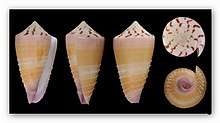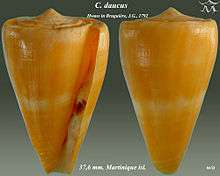Conus daucus
Conus daucus, common name the carrot cone, is a species of sea snail, a marine gastropod mollusk in the family Conidae, the cone snails and their allies.[1]
| Conus daucus | |
|---|---|
 | |
| Apertural and abapertural views of shell of Conus daucus Hwass in Bruguière, J.G., 1792 | |
 | |
| Scientific classification | |
| Kingdom: | Animalia |
| Phylum: | Mollusca |
| Class: | Gastropoda |
| Clade: | Caenogastropoda |
| Clade: | Hypsogastropoda |
| Clade: | Neogastropoda |
| Superfamily: | Conoidea |
| Family: | Conidae |
| Genus: | Conus |
| Species: | C. daucus |
| Binomial name | |
| Conus daucus | |
| Synonyms[1] | |
| |
Like all species within the genus Conus, these snails are predatory and venomous. They are capable of "stinging" humans, therefore live ones should be handled carefully.
There is one subspecies Conus daucus riosi Petuch, 1986
Description
The shell length varies between 19 mm and 66 mm.[2] The color of the shell is lemon- or orange-brown, grooved towards the base, with a pale, sometimes interrupted central band, and encircled throughout by rows of small chestnut spots often obsolete. The spire is sometimes maculated with pale chestnut.[3]
Distribution
This species occurs in the Caribbean Sea, the Gulf of Mexico, off Northeast Brazil, the North Atlantic Ridge, the Red Sea, and in the Indian Ocean off the Mascarene Basin.
Habitat
The minimum recorded depth for this species is 0 m; the maximum recorded depth is 120 m.[2]
References
- Conus daucus Hwass in Bruguière, 1792. Retrieved through: World Register of Marine Species on 27 March 2010.
- Welch J. J. (2010). "The "Island Rule" and Deep-Sea Gastropods: Re-Examining the Evidence". PLoS ONE 5(1): e8776. doi:10.1371/journal.pone.0008776.
- G.W. Tryon (1884) Manual of Conchology, structural and systematic, with illustrations of the species, vol. VI; Philadelphia, Academy of Natural Sciences
Further reading
- Da Motta A.J. & Raybaudi G. (1992) A new Conus (Gastropoda: Conidae) species found in Martinique. Publicacoes Ocasionais da Sociedade Portuguesa de Malacologia 16: 61-64.
- Petuch, E. J. 1993a. Molluscan Discoveries from the tropical western Atlantic region. Part II. New species of Conus from the Bahamas Platform, Central American and northern South American coasts, and the Lesser Antilles. La Conchiglia 24(265):10-15, figs.
page(s): 15, figs 20-21
- Filmer R.M. (2001). A Catalogue of Nomenclature and Taxonomy in the Living Conidae 1758 – 1998. Backhuys Publishers, Leiden. 388pp.
- Rosenberg, G., F. Moretzsohn, and E. F. García. 2009. Gastropoda (Mollusca) of the Gulf of Mexico, Pp. 579–699 in Felder, D.L. and D.K. Camp (eds.), Gulf of Mexico–Origins, Waters, and Biota. Biodiversity. Texas A&M Press, College Station, Texas
- Tucker J.K. (2009). Recent cone species database. September 4, 2009 Edition
- Tucker J.K. & Tenorio M.J. (2009) Systematic classification of Recent and fossil conoidean gastropods. Hackenheim: Conchbooks. 296 pp.
- Monnier E. & Limpalaër L. (2016). Revision of the Dauciconus daucus complex (Gastropoda: Conidae). Description of two new species: Dauciconus jacquescolombi n.sp. from Martinique and Dauciconus massemini n.sp. from French Guyana. Xenophora Taxonomy. 13: 6-37.
- Rabiller M. & Richard G. (2019). Conidae offshore de Guadeloupe : Description du matériel dragué lors de l'expédition KARUBENTHOS 2 contenant de nouvelles espèces. Xenophora Taxonomy. 24: 3-31.
 Conus daucus Hwass in Bruguière, J.G., 1792
Conus daucus Hwass in Bruguière, J.G., 1792 Conus daucus Hwass in Bruguière, J.G., 1792
Conus daucus Hwass in Bruguière, J.G., 1792
External links
- Hwass C.H. (1792). Cone. Conus. Pp. 586-757, in Bruguière J.G.. Encyclopédie méthodique ou par ordre de matières. Histoire naturelle des vers. volume 1. Pancoucke, Paris. [13 Feb. 1792; date after Evenhuis, 2003, Zootaxa, 166: 37; Zootaxa, 207
- Lamarck [J.B.M.de. (1810). Sur la détermination des espèces parmi les animaux sans vertèbres, et particulièrement parmi les Mollusques testacés. Annales du Muséum d'Histoire Naturelle. 15: 20-40]
- Adams A. (1855 ["1854"). Descriptions of thirty-nine new species of shells, from the collection of Hugh Cuming, Esq. Proceedings of the Zoological Society of London. 22: 130-138, pl. 28]
- Green J. (1830). Monograph of the cones of North America, including three new species. Transactions of the Albany Institute. 1: 121-125, pl. 3
- Reeve, L. A. (1844 ["1843"). Descriptions of new species of shells figured in the ‛Conchologia Iconica'. Proceedings of the Zoological Society of London. 11: 168-197]
- The Conus Biodiversity website
- Cone Shells - Knights of the Sea
- "Dauciconus daucus daucus". Gastropods.com. Retrieved 22 January 2012.
- Puillandre N., Duda T.F., Meyer C., Olivera B.M. & Bouchet P. (2015). One, four or 100 genera? A new classification of the cone snails. Journal of Molluscan Studies. 81: 1-23
- Rosenberg, G.; Moretzsohn, F.; García, E. F. (2009). Gastropoda (Mollusca) of the Gulf of Mexico, Pp. 579–699 in: Felder, D.L. and D.K. Camp (eds.), Gulf of Mexico–Origins, Waters, and Biota. Texas A&M Press, College Station, Texas
| Wikimedia Commons has media related to Conus daucus. |